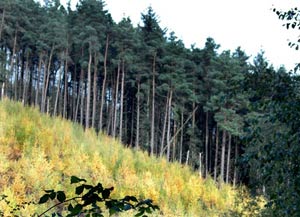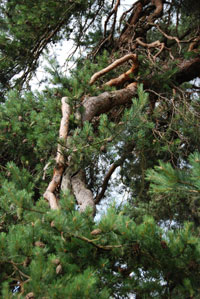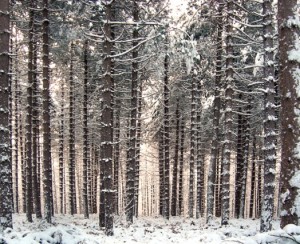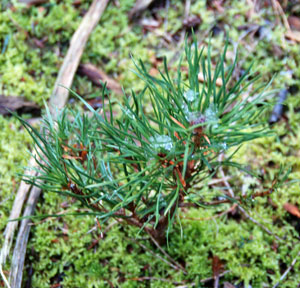Woodland types : Coniferous plantations

Coniferous plantations are found throughout the U.K. There are some 300,000+ hectares in England, 900,000+ hectares in Scotland, and circa 106,000 hectares in Wales. Large scale conifer planting ‘took off’ soon after the First World War. At about this time, the woodland cover had fallen to 5% (in Britain) so the Forestry Commission was established. This had the aim of ensuring that there would be a strategic reserve of timber.
Vast areas of ‘low grade’ land were pressed into service. Areas around Thetford and Kielder were used, as were some sandy coastal sites (e.g. Holkham in Norfolk) and many large tracts in Scotland (including the use of some natural peatlands).
Coniferous plantations may form dark, regular, ‘rectangular; blocks of almost uniform colour – as natural as any other monoculture! (such as a sugar cane or palm oil plantations). Whilst Scots Pine, Yew and Juniper are conifers native to the U.K, the majority of trees in coniferous plantations are introduced species – such as Douglas Fir, Corsican Pine, Sitka Spruce and Larch (though this is deciduous).
Scots Pine is also planted; it has a number of attractions.
- It is a long-lived tree and will often go on for at least 150-200 years,
- The orange bark that appears half way up the trunks and into the crown, offset by the bluish-green needle foliage, is most attractive.
- Scots pine produces cones in most years providing seeds for crossbills, siskins and redpolls. The trees are also good habitat for the delightful goldcrest, members of the tit family, especially coal tits, and the long-eared owl.
- A benefit of this regular flowering and cone production is widespread natural regeneration. Scots Pine is sometime used in the ‘recreation’ of Caledonian Forest.
Douglas Fir (Pseudotsuga menziesii) originated in western Northern America. Its needles are said to smell of oranges when rubbed or crushed. They can grow to 100 metres or more in height and they are valuable timber trees. The sitka spruce (Picea sitchensis) is a fast growing conifer (reaching up to 50 metres), again from North America. It can grow in upland areas, and in wet and / or acid soil. Its needles have a bluish tinge and the branches point upwards.
They can grow to 100 metres or more in height and they are valuable timber trees. The sitka spruce (Picea sitchensis) is a fast growing conifer (reaching up to 50 metres), again from North America. It can grow in upland areas, and in wet and / or acid soil. Its needles have a bluish tinge and the branches point upwards.
Corsican pine is another non-native tree, and is more productive tree than Scots pine – growing faster with straighter trunks, though less valuable for wildlife. The trees are also long-lived and can grow to large size. Corsican pine can be susceptible to red band needle blight.
Some plantations have a very high density of planting (and the trees may be remarkably uniform in age) – in consequence, the light intensity at ground level is low. Low light intensity coupled with a deep layer of needle litter inhibits or prevents the growth of many plant species. However, along access rides and in thinned areas  various (heathland) species and bracken can grow.
various (heathland) species and bracken can grow.
As conservation and biodiversity now form part of the Forestry Commission remit (e.g. Open Habitats policy) so mosaics of different aged stands form as a result of shifting ‘clear fell’, the introduction of firebreaks and creation of clearings and rides. Consequently, coniferous plantations can and do support wildlife. For example, birds that favour scrub (e.g. warblers), black grouse like young pine trees, night jars, long eared owls and bats appears at dusk and goshawks and osprey nest in tall pines – plus red and roe deer are to be found in plantations. Plantations with a variety of conifers offer ‘strongholds’ for red squirrels, and the orchid creeping lady’s tresses is found in pinewoods in areas as diverse as Scotland, Cumbria and East Anglia.
Comments are closed for this post.
Discussion
Very useful article and very helpful comment, thanks Linda Wilson.
This is a good article and great reason why we should be keeping and managing our conifer plantations.
Whilst participating in a Countryside Management course a few years ago we were informed that coniferous monoculture was not desirable and did not provide a great home for flora and fauna. I did not feel that this was a fair review of this type of woodland at the time but accepted that the experts know better.
However, my husband and I took a holiday in Coed y Brenin forest located in West Wales during 2006 which was a revelation to me. A vast coniferous forest with many footpaths enabling the walker to come across past industrial uses, fleeting glimpses of deer, hares, various birdlife and joy of joy, a pinemarten. Mosses, ferns and numerous flora were everywhere. It was too early in the year to see what fungi might abound but I am sure there will be many species.
2010 a small plantation of sitka spruce and larch came up for sale not far from our home. We did not think twice, we bought it. Come August there is plenty of fungi and many ferns and mosses all year round. There are resident populations of Coal Tits, Goldcrest, blackbird, robins, wrens, greater spotted woodpecker. Crossbills have been spotted on a couple of visits. We occasionally glimpse treecreepers and have been told that a goshawk utilises the wood. Numerous amphibians live within and we see grass snakes when we can walk quietly along the grassy main rides.
Our management of this plantation is minimal. We take out windblown trees for firewood and if enough room is created by this action we replant with broadleaf. There are native willows, hawthorn, ash etc. coming through of their own accord but we would like to keep the Sitka as the main stand.
There is a section of windblown sitkas which will be left for posterity. We think they were blown over during the 1987 gales and many have survived by sending up side branches mimicking trees in their own right. All these fallen trees are now covered in mosses creating a Jurassic atmosphere.
Now I have experienced conifer plantations at close quarters I see now they have a place in our countryside. Yes there are minimal dry areas where nothing seems to live underneath these trees but I am often surprised to see a toadstool pop it’s head out of the soil even here. I am positive I have only seen a minute proportion of all the species which live in our woodland. Certainly I would question anyone who says conifer plantations have no value in our countryside, wonder if our lecturers from a few years ago still feel that way.

I also live in Wales. I think conifer plantations are a ‘blot on the landscape’
The conifer plantation opposite my house is ‘past it’s sell by date’
It looks like a warzone as it has not been properly managed.
Two weeks ago trees fell onto the road bringing down my telephone line & splitting a telephone pole in half. Luckily nobody was killed or injured but if someone doesn’t do something soon there will be serious consequences.
gillian hopkins
16 June, 2017